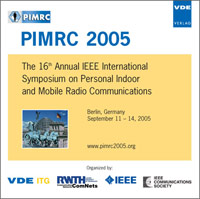Determinist Contention Window Algorithm for IEEE 802.11
Konferenz: PIMRC 2005 - 16th Annual IEEE International Symposium on Personal Indoor and Mobile Radio Communications
11.09.2005 - 14.09.2005 in Berlin, Germany
Tagungsband: PIMRC 2005
Seiten: 5Sprache: EnglischTyp: PDF
Persönliche VDE-Mitglieder erhalten auf diesen Artikel 10% Rabatt
Autoren:
Ksentini, Adlen; Naimi, Mohammed (LICP EA 2175, Université de Cergy-Pontoise, 3 Av. Adolph Chauvin, 95302 Cergy-Pontoise, France)
Nafaa, Abdelhamid; Gueroui, Abdelhak (PRiSM CNRS, Université de Versailles, 45 Av. des Etats-Unis, 78035 Versailles, France)
Inhalt:
With the widespread IEEE 802.11 networks use, strong needs to enhance Quality of Service (QoS) has appeared. The IEEE 802.11 Medium Access Control (MAC) protocol provides a contention-based distributed channel access mechanism that allow for wireless medium sharing. This protocol involves a significant collision rate as the network gets fairly loaded. Although the Contention Window (CW) is doubled after each collision, active stations may randomly select a backoff Timer value smaller than the preceding one. This is obviously sub-optimal since the backoff values should rather increase after each collision in order to further space between successive transmissions and thus absorbing the growing contending flows. In this paper, we propose a novel backoff mechanism, namely "Determinist Contention Window Algorithm (DCWA)", which further separates between the different backoff ranges associated to the different contention stages. Instead of just doubling the upper bound of the CW, DCWA increases both backoff range bounds (i.e., upper and lower bounds). On the other hand, after each successful transmission the backoff range is readjusted by taking into account current network load and past history. Simulation results show that DCWA outperforms both the Distributed Coordination Function (DCF) and the Slow Decrease (SD) scheme in terms of responsiveness to network load fluctuations, network utilization, and fairness among active stations.


